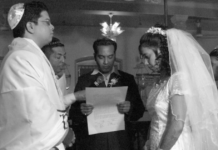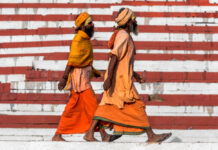Title: Salaam Shalom: The Jews of India
Director: Vanessa C. Laufer
Date released: 2001
Country Published: USA
Studio: Filmakers Library
Description:
It is hard to imagine a subject more exotic than the Jews of India. On the Indian subcontinent where Hindus and Muslims dominate, Jews are a much tinier minority than in the West. While it is clear they physically resemble their Indian neighbors, indicating more assimilation than is readily described or even admitted in this documentary, Indian Jewish communities are said to have maintained their religious integrity while enjoying a large measure of social acceptance.
The origins of this video project to document the history of the Jews of India are murky. They appear to be based in Canada, where Indian-Jewish immigrants and their children were being subjected to ridicule because of their strange appearance and customs. Trusting that education is the way to counteract discrimination and achieve harmony and understanding, filmmaker Vanessa C. Laufer and a few like-minded Canadians set about gathering information on the roots of Indian Jews in order to weave them into a cultural history through which these Jews could gain pride.
Ms. Laufer filmed extensive interviews with Jews of Indian background in Canada and Israel as well as with Jews still living in India; and captured splendid footage of the exteriors and interiors of many Indian synagogues, and Jewish enclaves. However, despite the age of the buildings and many of the parishioners, they are wrapped in prayer shawls that look brand new. Other factors seem to be at work here, but the mystery is never resolved.
Four groups are identified and described: Cochini and B’nei Israel Jews, who settled along the West Coast; Baghdadi Jews, who settled in the south central region; and B’nei Menasha Jews, who settled in India’s northeastern corner. The B’nei Menasha Jews share the physical attributes of the peoples of China and Tibet, and do not resemble the others. These communities are believed to have migrated to India from different places at different times, and did not intermingle after settling in India. The most ancient group is thought to have arrived after the destruction of the Second Temple, about 70 C.E., although some say they came even earlier. Some Indian religious practices are so ancient they do not reflect rabbinic Judaism (religious laws and rituals developed over many generations following the Biblical period).
Filming is beautiful and the production is well edited (the National Film Board of Canada may have lent its expertise here), but two flaws make for an unsatisfying result. First, speech is often hard to understand. The narrator’s voice, while mellifluous, sometimes fades away or is swallowed by background music; and some of the speakers’ English is heavily accented. There are titles for some passages, but more are needed. Second, establishing shots sometimes fail to clarify locale. Cutting back and forth among countries and individuals often is hard to interpret—are we in India or Israel? Do the speakers live in Canada or India? The story told here is that Indian Jews lived in perfect harmony with non-Jews for two millennia. When India achieved independence in 1947 and the state of Israel was established in 1948, this harmony was shattered by political events and Jews began to emigrate. Today, only a handful remain, but they live happily, unoppressed in India.
Technical problems and the potential for inaccuracy, since purported facts are based solely on the interviewees’ oral traditions, make this less valuable than it might have been, given the lack of alternative titles on the subject. Nevertheless, it opens a door and is full of vivid images.
Recommended for acade




